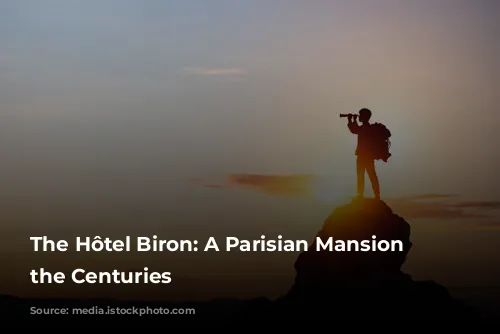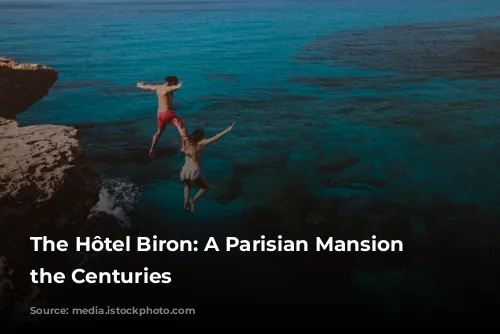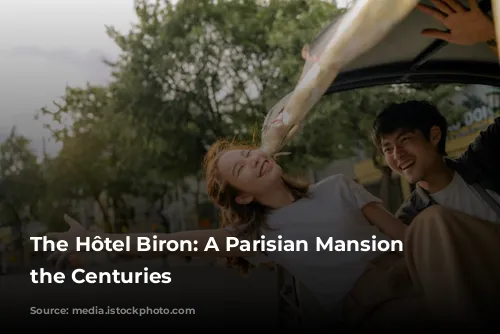The Hôtel Biron, a prominent landmark in Paris, boasts a rich history that spans centuries, each era leaving its mark on the estate’s architecture and grounds. The mansion’s story begins in the 18th century, where it was initially owned by Abraham Peyrenc de Moras, a wealthy merchant who commissioned its construction.
A Home for Nobility
After de Moras’s passing in 1736, his widow rented the mansion to the Duchess of Maine, a renowned noblewoman. While she made few changes to the mansion’s exterior, the interior underwent significant alterations. Upon the duchess’s death in 1753, the estate was acquired by Louis-Antoine de Gontaut-Biron, who became known as Marshal Biron. His passion lay in transforming the grounds, which had already established a reputation for their beauty.
A Garden of Enchantment
Marshal Biron, recognizing the potential of the gardens, undertook ambitious renovations. He doubled the size of the ornamental garden, adding a circular pool and incorporating an English-style garden, a novel concept at the time. This blend of traditional French and English garden styles created a unique and enchanting landscape. The estate’s kitchen garden, a legacy of the original owner, was relocated to a new area, preserving its vital role in the estate’s functionality.
A Glimpse into the Past
The appearance of the gardens during Marshal Biron’s tenure is well-documented, thanks to detailed descriptions and engravings published between 1776 and 1778. These accounts provide invaluable insights into the grandeur and beauty of the gardens during this period. Marshal Biron’s enduring legacy is the name by which the mansion is still known today – the Hôtel Biron.

Transformations and Tenants: A Changing Landscape
Following Marshal Biron’s death in 1788, the Hôtel Biron experienced a succession of owners and tenants, each leaving their mark on the estate. The mansion was witness to a wide range of uses and transformations, reflecting the changing social and political landscape of Paris.
A Feast for the Senses
In 1795, the Duke of Charost, a prominent figure of the time, took possession of the mansion. He embraced the popular trend of English gardens and transformed the kitchen garden into one, complete with a picturesque body of water. Recognizing the estate’s unique charm, he leased it for a year, hosting extravagant events for the public. These gatherings, set amidst the idyllic countryside, offered a fusion of entertainment, including games, dances, musical performances, and firework displays, creating a vibrant and festive atmosphere.
A Home for Diplomacy and Religion
The Hôtel Biron served as a venue for diplomatic endeavors. In 1806-10, the mansion was leased to the Holy See, providing lodging for one of the papal legates, Cardinal Caprara. A few years later, in 1810-11, the Emperor of Russia established his embassy at the Hôtel Biron, further cementing the estate’s role in international affairs.
A Sanctuary for Education and Faith
In 1820, a significant shift occurred in the ownership of the Hôtel Biron. The Duchess of Charost sold the entire property, including its outbuildings, to a group of three nuns, one of whom was the Reverend Mother Madeleine-Louise-Sophie Barat, founder of the Society of the Sacred Heart of Jesus. The religious congregation saw the potential of the estate as a place of learning and established a boarding school for girls. To adapt the buildings and grounds to their new purpose, extensive alterations were made, transforming the mansion into a haven for education and faith.
A Legacy of Change
Throughout their occupancy, the nuns gradually altered the original decoration, selling valuable wood paneling, wrought ironwork, and painted decorations to discerning collectors to finance the ongoing renovations. The original charm of the Hôtel Biron, built by de Moras, began to fade as the estate took on a new identity under the influence of the nuns. In 1839, a significant change to the grounds occurred: Marshal Biron’s pool was filled in to construct a mound, where an ex-voto dedicated to the Virgin was erected. By the late 19th century, the gardens had evolved into a functional mix of kitchen garden, orchard, and pastureland, reflecting the nuns’ practical approach to the estate.
A New Chapter in Education
To accommodate the growing needs of the boarding school, several new buildings were constructed between 1820 and 1904. These included classrooms, dormitories, and a chapel, which was designed by the architect Jean Juste Gustave Lisch and completed in 1876. The chapel, a testament to the nuns’ dedication to faith, became a central feature of the estate, signifying the importance of religion in their lives.
The End of an Era
In July 1904, the Society of the Sacred Heart of Jesus was dissolved. The nuns were evicted from the Hôtel Biron, and the property was placed under the control of a receiver. This marked the end of an era for the estate, as the nuns’ influence on its character came to an end.

A Creative Haven: The Hôtel Biron in the 20th Century
After the nuns’ departure, the Hôtel Biron stood vacant, awaiting its next chapter. The estate was put up for sale, and while potential buyers were sought, tenants were allowed to occupy the mansion. The Hôtel Biron soon attracted a captivating mix of artists, writers, and intellectuals, transforming the estate into a vibrant hub of artistic expression.
A Gathering of Creative Minds
Among those who sought refuge within the Hôtel Biron’s walls were Jean Cocteau, a renowned writer, and Henri Matisse, a prominent painter. Isadora Duncan, a revolutionary dancer, and Clara Westhoff, a sculptress and future wife of the poet Rainer Maria Rilke, also found inspiration within the estate’s historic walls. Westhoff’s connection to the estate played a crucial role in the Hôtel Biron’s next chapter.
Rodin Finds Inspiration
It was Rilke who first introduced Auguste Rodin, the renowned sculptor, to the Hôtel Biron in 1908. Captivated by the estate’s potential, Rodin rented four ground-floor rooms with south-facing terraces, transforming them into his studios. Rodin was drawn to the estate’s wild and untamed gardens, finding inspiration in their natural beauty. He incorporated some of his sculptures and antique collection into the garden’s verdant landscape, seamlessly blending his art with the estate’s natural charm.
A Legacy of Art
Rodin’s presence at the Hôtel Biron marked a significant turning point in the estate’s history. From 1911 onwards, he occupied the entire mansion, using it as his studio and home. The estate became a vibrant center of artistic activity, where Rodin’s sculptures were created and displayed. His time at the Hôtel Biron, a period of immense creative productivity, marked the estate’s transformation from a place of education and faith into a sanctuary for art. The Hôtel Biron became synonymous with Rodin, its gardens echoing with the whispers of his artistic genius.












